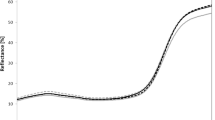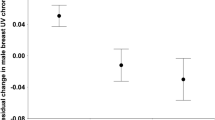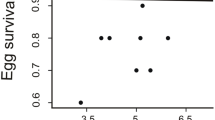Abstract
Sexual dichromatism and phenotypic variation in elaborate male traits are common products of sexual selection. The spectral properties of carotenoid and structurally-based plumage colors and the patch sizes of melanin-based plumage colors have received considerable attention as sexual signals in birds. However, the importance of variation in achromatic plumage colors (white, gray and black) remains virtually unexplored, despite their widespread occurrence. We investigated a potential signal function of the achromatic black and white plumage of black-capped chickadees (Poecile atricapilla). We captured and color-banded 178 free-living chickadees and assessed winter flock dominance hierarchies by tabulating pairwise interactions at feeders. We recaptured 73 of these birds and measured plumage coloration for six body regions using a reflectance spectrometer and the area of melanin-based plumage patches from standardized photographs. We found extensive individual variation in chickadee plumage traits and considerable sexual dichromatism. Male black-capped chickadees have significantly brighter white plumage than females, larger black patches, and greater plumage contrast between adjacent white and black plumage regions. We also found rank differences in the plumage reflectance of males; high-ranking males, who are preferred by females as both social and extra-pair partners, exhibit significantly darker black plumage and grow their feathers more rapidly than low-ranking males. This variation among individuals reveals a potential signal function for achromatic plumage coloration in birds.



Similar content being viewed by others
References
Andersson MB (1994) Sexual selection. Princeton University Press, Princeton, N.J.
Andersson S, Örnborg J, Andersson M (1998) Ultraviolet sexual dimorphism and assortative mating in blue tits. Proc R Soc Lond B 265:445–450
Badyaev AV, Hill GE, Dunn PO, Glenn JC (2001) Plumage color as a composite trait: developmental and functional integration of sexual ornamentation. Am Nat 158:221–235
Bonser RHC (1995) Melanin and the abrasion resistance of feathers. Condor 97:590–591
Chen DM, Goldsmith TH (1986) Four spectral classes of cone in the retinas of birds. Comp Physiol. A 159:473–479
Cuthill IC, Partridge JC, Bennett ATD, Church SC, Hart NS, Hunt S (2000) Ultraviolet vision in birds. Adv Study Behav 29:159–214
Dale J, Lank DB, Reeve HK (2001) Signaling individual identity versus quality: a model and case studies with Ruffs, Queleas, and House Finches. Am Nat 158:75–86
Darwin C (1871) The descent of man and selection in relation to sex. Murray, London
Doucet SM (2002) Structural plumage coloration, male body size, and condition in the blue-black grassquit. Condor 104:30–38
Doucet SM, Montgomerie R (2003) Multiple sexual ornaments in satin bowerbirds: UV plumage and bowers signal different aspects of male quality. Behav Ecol (in press)
Endler JA (1990) On the measurement and classification of colour in studies of animal colour patterns. Biol J Linn Soc 41:315–352
Ficken MS, Weise CM, Popp JW (1990) Dominance rank and resource access in winter flocks of Black-capped Chickadees. Wilson Bull 102:623–633
Fitze PS, Richner, H (2002) Differential effects of a parasite on ornamental structures based on melanins and carotenoids. Behav Ecol 3:401–407
Fox DL (1976) Animal biochromes and structural colours. Univiversity of California Press, Berkeley
Gochfeld M (1977) Plumage variation in Black-capped Chickadees: Is there sexual dimorphism? Bird-Banding 48:62–66
Griffiths R, Double MC, Orr K, Dawson RG (1998) A DNA test to sex most birds. Mol Ecol 7:1071–1075
Griffith SC, Owens IPF, Burke T (1999a) Environmental determination of a sexually selected trait. Nature 400:358–360
Griffith SC, Owens IPF, Burke T (1999b) Female choice and annual reproductive success favour less-ornamented male house sparrows. Proc R Soc Lond B 266:765–770
Grubb TC (1991) A deficient diet narrows growth bars on induced feathers. Auk 108:725–727
Hart NS (2001) The visual ecology of avian photoreceptors. Prog Retin Eye Res 20:675–703
Hill GE (1991) Plumage coloration is a sexually selected indicator of male quality. Nature 350:337–339
Hill GE (2002) A red bird in a brown bag: the function and evolution of colorful plumage in the house finch. Oxford University Press, New York
Hill GE, Montgomerie R (1994) Plumage colour signals nutritional condition in the house finch. Proc R Soc Lond B 258:47–52
Hunt S, Bennett ADT, Cuthill IC, Griffiths R (1998) Blue tits are ultraviolet tits. Proc R Soc Lond B 265:451–455
Järvi T, Bakken M (1984) The function of the variation in the breast stripe of the great tit (Parus major). Anim Behav 32:590–596
Jenkins KD, Hawley DM, Farabaugh CS, Cristol DA (2001) Ptilochronology reveals differences in condition of captive White-throated Sparrows. Condor 103:579–586
Keyser AJ, Hill GE (2000) Structurally based plumage coloration is an honest signal of quality in male blue grosbeaks. Behav Ecol 11:202–209.
Lemel J, Wallin K (1993) Status signaling, motivational condition and dominance: an experimental study in the great tit, Parus major. Anim Behav 45:549–558
McGraw KJ, Dale J, Mackillop EA (2003) Social environment during molt and the expression of melanin-based plumage pigmentation in male house sparrows (Passer domesticus). Behav Ecol Sociobiol 53:116-122
Mennill DJ, Ratcliffe LM, Boag PT (2002) Female eavesdropping on male song contests in songbirds. Science 296:873
Michener H, Michener JR (1938) Bars in flight feathers. Condor 40:149–160
Møller AP (1987) Variation in badge size in male house sparrows Passer domesticus: evidence for status signaling. Anim Behav 35:1637–1644
Møller AP, Birkhead TR (1994) The evolution of plumage brightness in birds is related to extra-pair paternity. Evolution 48:1089–1100
Mosher JI, Lane S (1972) A method of determining the sex of captured Black-capped Chickadees. Bird-Banding 43:139–140
Norris K (1993). Heritable variation in a plumage indicator of viability in male great tits Parus major. Nature 362:537–539
Otter K, Ratcliffe L (1999) Relationship of bib size to age and sex in the black-capped chickadee. J Field Ornithol 70:567–577
Otter K, Chruszcz B, Ratcliffe L (1997) Honest advertisement and song output during the dawn chorus of black-capped chickadees. Behav Ecol 8:167–173
Otter K, Ratcliffe L, Michaud D, Boag PT (1998) Do female black-capped chickadees prefer high-ranking males as extra-pair partners? Behav Ecol Sociobiol 43:25–36
Owens IPF, Hartley IR (1998) Sexual dimorphism in birds: why are there so many different forms of dimorphism? Proc R Soc Lond B 265:397–407
Pärt T, Qvarnström A (1997) Badge size in collared flycatchers predicts outcome of male competition over territories. Anim Behav 54:893–899
Prum RO (1999) The anatomy and physics of avian structural colours. In: Adams N, Slotow R (eds) Proc Int Ornithol Congr 22:1633–1653
Pyle P, Howell SNG, Yunick RP, DeSante DF (1987) Identification guide to North American passerines. Slate Creek Press, Bolinas, Calif.
Qvarnström A (1999). Genotype-by-environment interactions in the determination of the size of a secondary sexual character in the collared flycatcher (Ficedula albicollis). Evolution 53:1564–1572
Ramsay SM, Otter KA, Mennill DJ, Ratcliffe LM, Boag PT (2000) Divorce and extrapair mating in female black-capped chickadees (Parus atricapillus): separate strategies with a common target. Behav Ecol Sociobiol 43:25–36
Senar JC (1999) Plumage coloration as a signal of social status. In: Adams N, Slotow R (eds) Proc Int Ornithol Congr 22:1669–1686
Siitari H, Honkavaara J, Huhta E, Viitala J (2002) Ultraviolet reflection and female mate choice in the pied flycatcher, Ficedula hypoleuca. Anim Behav 63:97–102
Smith SM (1991) The Black-capped Chickadee: Behavioral Ecology and Natural History. Cornell University Press, Ithaca, N.Y.
Smith SM (1993) Black-capped chickadee (Parus atricapillus). In: Poole A, Gill F (eds) The Birds of North America, no 39. The Birds of North America, Philadelphia
Thusius KJ, Peterson KA, Dunn PO, Whittingham LA (2001) Male mask size is correlated with mating success in the common yellowthroat. Anim Behav 62:435–446.
Veiga JP, Puerta M (1996) Nutritional constraints determine the expression of a sexual trait in the house sparrow, Passer domesticus. Proc R Soc Lond B 263:229–234.
Vorobyev M, Osorio D, Bennett ATD, Marshall NJ, Cuthill IC (1998) Tetrachromacy, oil droplets and bird plumage colours. J Comp Physiol A 183:621–633
Whitfield DP (1987) Plumage variability, status signaling and individual recognition in avian flocks. Trends Ecol Evol 2:13–18
Acknowledgements
We thank James Hodson for field assistance, as well as J. Toohey and the Curtis, Lundell, Warren, Weatherhead-Metz, and Zink families for access to their properties. This research was funded by the Natural Sciences and Engineering Research Council of Canada (scholarships to D.J.M. and S.M.D. and research and equipment grants to R.M. and L.M.R.) and by grants from the American Ornithologists' Union, the Frank M. Chapman Memorial Fund, and the James L. Baillie Memorial Fund of Bird Studies Canada to D.J.M.
Author information
Authors and Affiliations
Corresponding author
Additional information
Communicated by M. Elgar
Rights and permissions
About this article
Cite this article
Mennill, D.J., Doucet, S.M., Montgomerie, R. et al. Achromatic color variation in black-capped chickadees, Poecile atricapilla: black and white signals of sex and rank. Behav Ecol Sociobiol 53, 350–357 (2003). https://doi.org/10.1007/s00265-003-0581-8
Received:
Revised:
Accepted:
Published:
Issue Date:
DOI: https://doi.org/10.1007/s00265-003-0581-8




